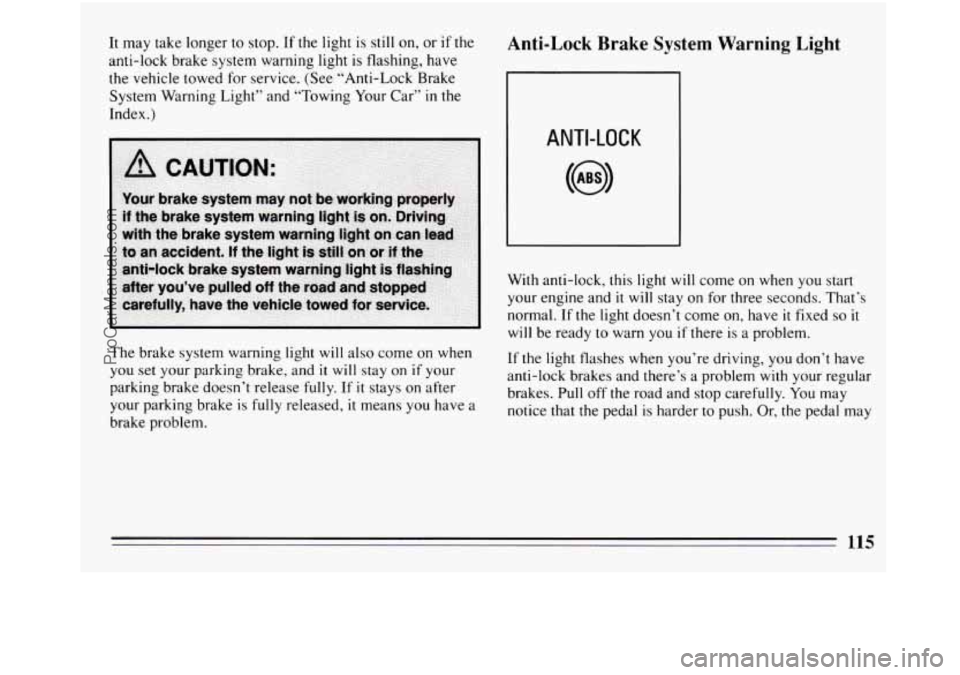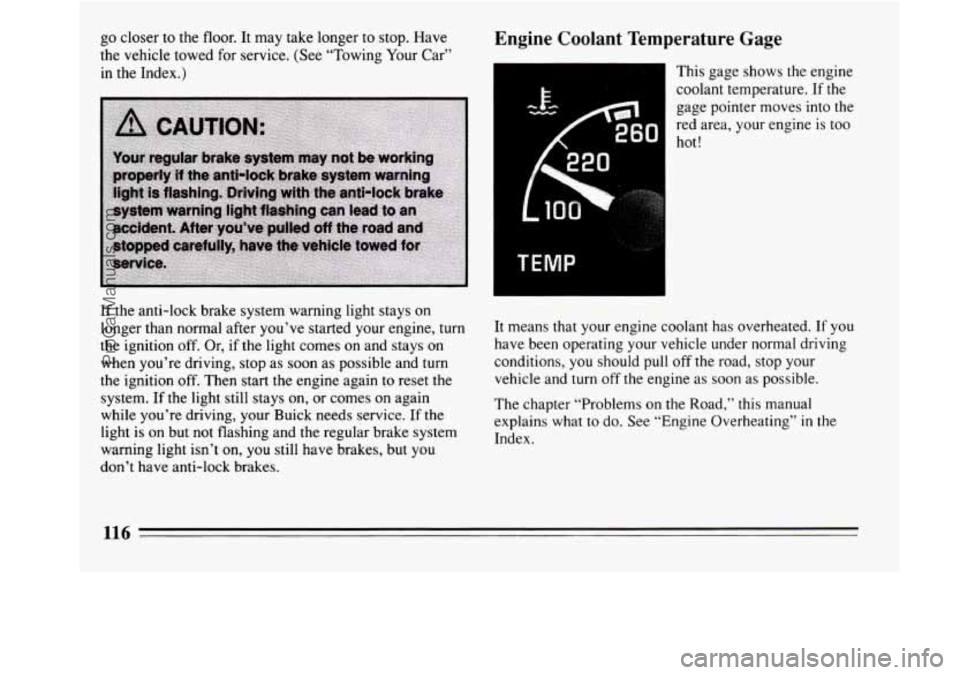Page 80 of 308

PASS-Key@II
Your vehicle is
equipped
with the
PASS-Key@II
(Personalized
Automotive Security
System) theft deterrent
system. PASS-Key(%
is a passive theft
deterrFnt system. This
means you don’t have
to do anything different
to arm or disarm the
system.
It works
when you insert or remove the key from the
ignition. PASS-Key% uses a resistor pellet
in the
ignition key that matches a decoder
in your vehicle.
When the PASS-Key% system senses that someone
is
using the wrong key, it shuts down the vehicle’s starter
and
fuel systems. For about three minutes, the starter
won’t work and fuel won’t
go to the engine. If someone
tries to start your vehicle again or uses another key
during this time, the vehicle will not start. This
discourages someone from randomly trying different keys
with different resistor pellets in an
attempt to make
a match.
The ignition key must be clean and dry before it’s
inserted
in the ignition or the engine may not start. If the
engine does not start, the key may be dirty or wet. Turn
the ignition off.
Clean and dry the key. Wait about three minutes and
try
again. If the starter still won’t work, and the key appears
to be clean and dry, wait about three minutes and try the
other ignition key. At this time, you may also want to
check the fuse (see “Fuses and Circuit Breakers’’
in the
Index). If the starter won’t work
with the other key, your
vehicle needs service. If your vehicle does start, the first
ignition key may be faulty. See your Buick dealer or a
locksmith who can service
the PASS-Key@II.
If you accidentally use
a key that has a damaged or
missing resistor pellet, the starter won’t work. But you
don’t have to wait three minutes before trying one of
the
other ignition keys.
See your Buick dealer or a locksmith who can service
the PASS-Key(% to have a new key made.
If you lose or damage a PASS-Key% ignition key, see
your Buick dealer or a locksmith who can service
PASS-Key@II to have a new key made.
78
ProCarManuals.com
Page 82 of 308

E
With the ignition key in the ignition switch, you can turn
the switch to five different positions.
(A) Accessory: This position lets you use things like the
radio and the windshield wipers when the engine is off.
To
use, push in the key and turn it toward you. Your
steering wheel
will remain locked, just as it was before
you inserted the key.
(B) Lock: Before you put the key in, your ignition will
be in the Lock position. This position locks your
ignition, steering wheel and transaxle. It’s an theft
deterrent feature.
(C) Off: This position lets you turn off the engine but
stili
turn the steering wheel. It doesn’t lock the steering
wheel like “Lock.” Use “Off’
if you must have your car
in motion while the engine is off (example, if your car is
being pushed).
(D) Run: This is the position for driving.
(E) Start: This position starts your engine.
I NOTICE:
If your key seems stuck in “Lock” and you can’t
turn’it, be sure
it is all the way in. If it is, then turn
the steering wheel left and right while you turn
the key hard. But turn the key only with your
hand. Using
a tool to force it could break the key
or the ignition switch. If none of this works, then
your vehicle needs service.
Starting Your Engine
Engines start differently. The 8th digit of your Vehicle
Identification Number (VIN) shows the code letter or
number for your engine. You will find the VIN at the top
left of your instrument panel. (See “Vehicle
Identification Number’’
in the Index.) Follow the proper
steps to start the engine.
80
ProCarManuals.com
Page 117 of 308

It may take longer to stop. If the light is still on, or if the
anti-lock brake system warning light is flashing, have
the vehicle towed for service. (See “Anti-Lock Brake
System Warning Light” and “Towing Your Car” in the
Index.)
The brake system warning light will also come on when
you
set your parking brake, and it will stay on if your
parking brake doesn’t release
fully. If it stays on after
your parking brake is
fully released, it means you have a
brake problem.
Anti-Lock Brake System Warning Light
ANTI-LOCK
With anti-lock, this light will come on when you start
your engine and
it will stay on for three seconds. That’s
normal. If the light doesn’t come on, have
it fixed so it
will be ready to warn you if there is a problem.
If the light flashes when you’re driving, you don’t have
anti-lock brakes and there’s a problem with your regular
brakes. Pull
off the road and stop carefully. You may
notice that the pedal is harder to push. Or, the pedal may
115
ProCarManuals.com
Page 118 of 308

go closer to the floor. It may take longer to stop. Have
the vehicle towed for service. (See “Towing Your Car”
in the Index.) Engine Coolant Temperature Gage
This gage shows the engine
coolant temperature. If the
gage pointer moves into the
red area, your engine
is too
hot!
If the anti-lock brake system warning light stays on
longer than normal after you’ve started your engine, turn
the ignition off. Or,
if the light comes on and stays on
when you’re driving, stop as soon as possible and turn
the ignition off. Then start the engine again to reset the
system. If the light still stays on, or comes on again
while you’re driving, your Buick needs service. If the
light is on but not flashing and the regular brake system
warning light isn’t on,
you still have brakes, but you
don’t have anti-lock brakes. It means
that your engine coolant has overheated. If you
have been operating your vehicle under normal driving
conditions,
you should pull off the road, stop your
vehicle and turn off the engine as soon as possible.
The chapter “Problems on the Road,” this manual
explains what to do. See “Engine Overheating”
in the
Index.
116
ProCarManuals.com
Page 119 of 308
LOW Coolant Warning Light Engine Oil Pressure Gage
LOW
COOLANT
If this light comes on, your
system
is low on coolant
and the engine may
overheat.
See “Engine Coolant”
in the Index and have your
vehicle serviced as soon as you can.
1
You can read your engine
oil pressure directly from
the gage
on your instrument
panel.
If the gage reads in the red band and stays there, it
means oil isn’t going through your engine properly.
You
117
ProCarManuals.com
Page 120 of 308

could be low on oil, or you might have some other oil
problem. Have your vehicle serviced as soon
as you can.
NOTICE:
Damage to your engine from neglected oil
problems can be costly and is not covered by
your warranty.
Low Oil Warning Light
LOW
OIL
Your vehicle is equipped
with an oil level monitoring
system. When the ignition
key is turned on, the light
will flash briefly.
If the light stays on, stop the vehicle on a level surface and
turn
off the engine. Check the oil level using the engine oil
dipstick. See “Engine Oil” in the Index. If the light does
not flash, have the low oil level sensor system repaired so
it will be ready to warn you if there’s a problem.
Note: The oil level monitoring system only checks oil
level during the brief period between key
on and engine
crank. It does not monitor engine oil level when the
engine
is running. Additionally, an oil level check is
only performed
if the engine has been turned off for a
considerable period of time allowing the oil normally
in
circulation to drain back into the oil pan.
118
ProCarManuals.com
Page 122 of 308
Malfunction Indicator Lamp (Service Engine
Soon Light)
SERVICE
ENGINE
SOON
A computer monitors
operation
of your fuel,
ignition and emission
systems. This light should
come on when the ignition
is on and the engine
is not
running, as a check to show
you
it is working.
If the light does not come on at all, have it fixed right
away.
If it says on, or comes on while you are driving,
the computer
is indicating that you have a problem. You
should take your vehicle in for service soon.
NOTICE:
If you keep driving your vehicle with this light on,
after a while the emission controls won’t work as
well, your fuel economy won’t be as good and
your engine may not run as smoothly. This could
lead to costly repairs not covered by your
~ warranty.
rachometer
The tachometer tells you how fast the engine is running .
It shows speed in revolutions per minute (RPM). Do not
operate your engine
in the red line range. If you do you
can cause severe engine damage.
120
ProCarManuals.com
Page 137 of 308
Care of Your Cassette Tape Player
A tape player that is not cleaned regularly can cause
reduced sound quality, ruined cassettes, or a damaged
mechanism. Cassette tapes should be stored in their
cases away from contaminants, direct sunlight, and
extreme heat. If
they aren't, they may not operate
properly or cause failure of the tape player.
Your tape player should be cleaned regularly each
month or after every
15 hours of use. If you notice a
reduction in sound quality, try
a known good cassette to
see if the tape or the tape player is at fault. If this other
cassette has no improvement in sound quality, clean the
tape player.
Clean your tape player
with a wiping-action,
non-abrasive cleaning cassette, and follow the directions
provided with
it.
Cassettes are subject to wear and the sound quality may
degrade over time. Always make sure that the cassette
tape is
in good condition before you have your tape
player serviced.
135
ProCarManuals.com